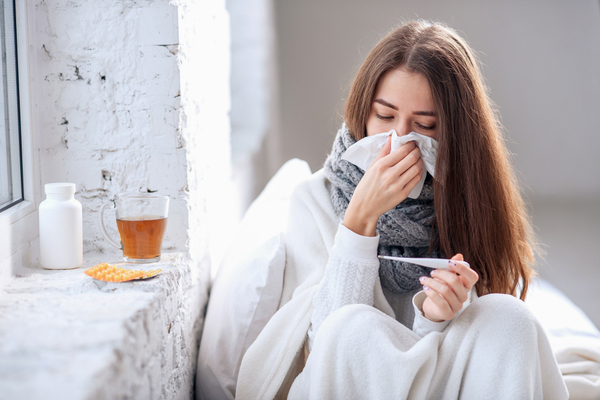Omicron has become the variant fastest to dominate COVID-19 infections among Americans, with officials at the Centers for Disease Control and Prevention indicating that it may make up over 95% of cases traced in early January, per CNBC. And while the suite of potential symptoms caused by this particular form of SARS-CoV-2 hasn’t changed — shortness of breath and loss of taste and smell are still very much possible for those who become sick — it seems healthcare providers are noticing a new trend.
Researchers tracing Omicron’s spread across the globe have released early data suggesting COVID-19 cases triggered by the Omicron variant seem to be less severe compared to those caused by the earlier Delta strain. That said, those tracking its spread have also noted that Omicron is causing symptoms that largely rest in the upper respiratory system, mostly the nose, mouth and throat, and not as many severe symptoms in other areas of the body.
“What is becoming clearer… is that Omicron seems to have less impact on lungs than prior variants,” Ronald Whelan, M.D., head of Discovery Health’s COVID-19 task team told CBS News. But as it’s seemingly becoming more common for Omicron symptoms to be in sync with upper respiratory issues, Americans may have trouble differentiating between common cold symptoms and potential signs of a COVID-19 infection.
Scott Roberts, M.D., an associate medical director of infection prevention at Yale New Haven Health, explains that the challenge to differentiate between a cold and COVID isn’t new, per se. “The most commonly reported symptoms of the omicron variant — similar to other variants — include sore throat, nasal congestion, headaches, muscle aches, fevers and cough.” Dr. Roberts adds that an early report out of South Africa suggests that Omicron patients have experienced less of a loss of taste and smell; those who are impacted by this strain, therefore, may be more confused than ever.
Night sweats are another less visible COVID-19 symptom that is being called into question currently by representatives of the United Kingdom National Health Service and even touched upon by medical correspondents on the Today show. All to say; is there a way to differentiate between seasonal cold symptoms and COVID? Dr. Roberts and other experts say you should keep the following symptoms in mind.
So, what are the symptoms of an Omicron COVID-19 infection?
“The symptoms between an Omicron infection compared to infections caused by other variants are more similar than they are different,” Dr. Roberts explains. While early evidence suggests that death and severe sickness are less likely with Omicron COVID-19 infections, any of the following symptoms may present within 2 to 14 days after being exposed to the virus.
- Fever and body chills
- Shortness of breath or difficulty breathing
- Headache
- Congestion or runny nose
- Sore throat
- Cough
- Severe Fatigue, or muscle and body aches
- Nausea
- Diarrhea
Health experts first reported that severe fatigue was quickly becoming a hallmark sign of an Omicron infection. Fatigue still remains a concern as Americans are more likely to experience it compared to breathlessness or a loss of taste and smell. But Dr. Roberts adds that emerging data suggest sore throat as a result of a COVID-19 infection may be underreported as social distancing has largely relaxed.
“We are seeing surges in respiratory virus infections right now, which is mainly due to the Omicron variant of COVID-19,” he says. “Unlike last year, however, when there were very few viruses besides COVID-19 going around due to public health restrictions, this winter has more places open — there is less masking, and so we are seeing more seasonal viruses such as influenza in the community.”
Is a Sore Throat a sign of an Omicron infection?
It can be hard to determine if the sore throat you are experiencing is due to a COVID-19 infection or due to another illness circulating around your community. In fact, Dr. Roberts stresses that some Americans may simply be experiencing a symptom caused by winter weather: “The most common causes of sore throat during the winter months are irritation from dry air with low humidity as well as respiratory viral infections, which are far more common in the winter than in summer,” he explains.
Not all COVID-19 cases are the same, and individuals may experience different symptoms at various degrees of severity — but Dr. Roberts suggests the key to understanding whether or not a sore throat is a hint of something more is to assess other concurrent symptoms. “Some sore throats are nothing more than irritations, while others can be signs of respiratory viral infections,” he adds.
The most significant clue that your sore throat could be something more serious may be other upper respiratory symptoms you’re experiencing, namely fever and nasal congestion at the same time, Dr. Roberts says. “The problem with COVID-19 is that many people may have mild symptoms,” he adds, stressing that sore throats aren’t always an immediate cause for concern. “If only a sore throat is present with no other symptoms, it is still safest to be cautious and get tested for COVID-19.”
The Bottom Line
Omicron may prove problematic for healthcare providers this winter as Americans will likely be unsure if symptoms are indicative of a cold or something more serious. This is especially true for those who have been fully vaccinated and boosted recently, as those who are unvaccinated may experience more aggressive symptoms, per federal health officials.
Sore throats that are simultaneously noticeable with any other cold symptom, particularly a harsh fever or respiratory congestion, should prompt you to seek a COVID-19 test as soon as possible. At-home rapid antigen tests are available in pharmacies and through retailers across the nation, and Dr. Roberts adds a sore throat would likely warrant using one of these tests. “But if the test is negative and there are symptoms present, a confirmatory PCR test should be done.”
—
Photo Credit: Gorynvd / Shutterstock.com
